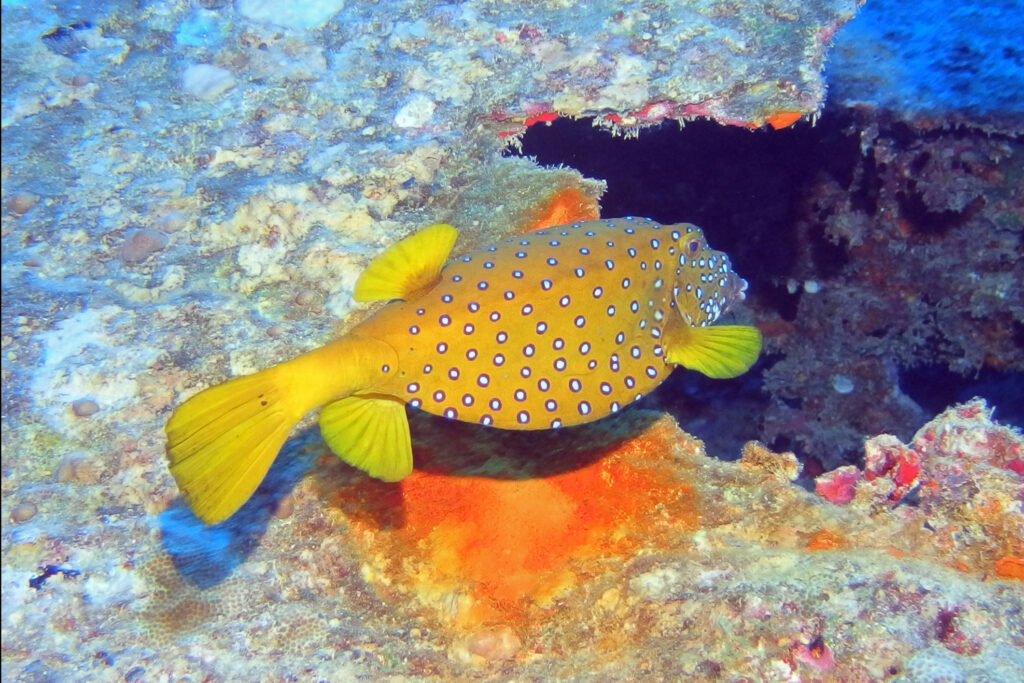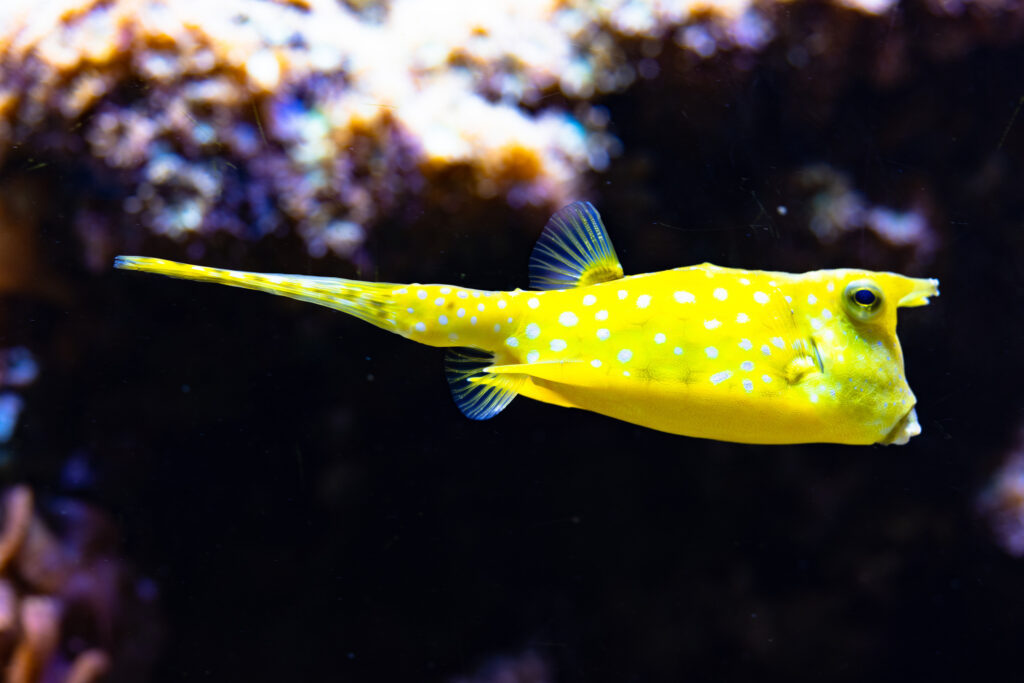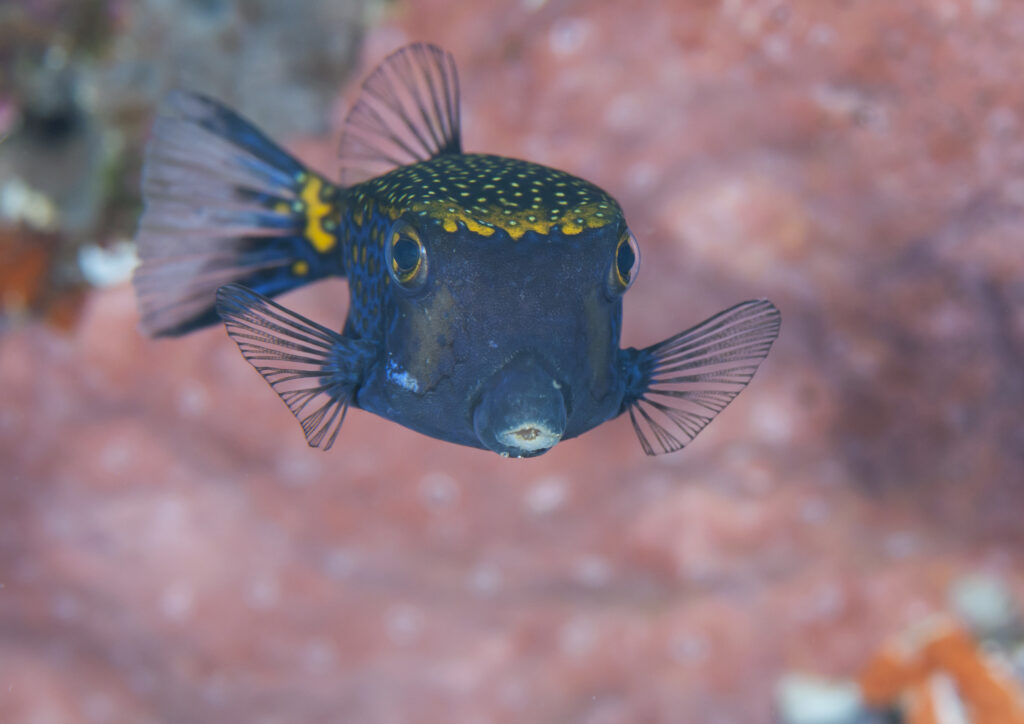Colourful, quirky, and full of surprises, boxfish are some of the ocean’s most fascinating creatures. At Hastings Aquarium, boxfish are some of our most visited fish because of their striking colours, patterns, and pouting expression.
There’s more than meets the eye with the boxfish, though. So, let’s embark on a journey of discovery about these incredible fish.
What is a boxfish?
Boxfish are a group of small, angular fish known for their rigid, box-like bodies. Their funny shape, alongside their vibrant colours and intriguing behaviours, makes them a favourite of Hastings Aquarium guests.
Scientifically, boxfish fall under the family Ostraciidae, within the order Tetraodontiformes, the same group that includes pufferfish and triggerfish. The fish within this group are famous for their odd body shapes, setting them apart from other orders of fish.
1. There are 23 species of boxfish

According to current estimations, there are about 23 recognised species of boxfish. Some of the better-known varieties include:
- Yellow boxfish (Ostracion cubicus)
- Black boxfish (Ostracion meleagris)
- Horned boxfish (Lactoria fornasini)
While each species varies slightly in appearance, behaviour, and habitat, they all share common characteristics like honeycomb patterns on their skin.
1. Boxfish and pufferfish are related
Interestingly, boxfish and pufferfish are close cousins. However, while pufferfish are famous for their ability to inflate their bodies when threatened, boxfish do not have this capability. Instead, they rely on their hard, bony carapace for protection.
2. Boxfish appearance changes with age
One of the most enchanting aspects of boxfish is how they change as they grow.
3. Colour
Juvenile boxfish, especially the yellow boxfish, are bright yellow with black spots. As they mature, their colours often shift to blue, grey, or brown, sometimes displaying intricate patterns, adding to their beauty.
Shape and size
Most boxfish maintain their distinctive boxy shape throughout their lives, but their size increases from a few centimetres as juveniles to around 15-20cm in adulthood, depending on the species.
Unique features
Some species, like the Longhorn cowfish, develop prominent “horns” as they age. The horns are mostly hollow, made of mineralised collagen fibres and can grow back in just a few months if they’re damaged.
4. Boxfish defence mechanisms
Despite their slow movements and cute appearance, boxfish are well-equipped to defend themselves. Their key defence strategies include:
Toxins
Some boxfish can release a toxic substance from their skin when stressed, deterring predators from making a meal of them.
Colour changes
Their bright juvenile colouring can warn predators of their toxicity, a strategy called aposematism.
Clicking noises
Some boxfish can produce clicking sounds, possibly as a form of communication or warning to would-be predators.
5. Boxfish are poor swimmers
If fish were vehicles, a boxfish would be something like a small van. While their body shape is practical for defence, they’re far from hydrodynamic, making them slow, poor swimmers. Instead of gliding smoothly through the water, they “sway” or “wiggle,” using small pectoral fins, a dorsal fin, and an anal fin to manoeuvre. Their unusual swimming style is slow but extremely stable, making them expert hoverers within coral reefs.

1. Coral reefs are the typical habitat for boxfish
Boxfish typically inhabit coral reefs, lagoons, and seagrass beds in tropical and subtropical oceans. These colourful environments allow them to use their vibrant patterns to blend in and source a rich diet of algae, sponges, molluscs, and small crustaceans.
2. Males can become territorial
Male boxfish are known to guard their territories fiercely. During breeding seasons, they defend their areas against rival males, ensuring they have the best access to females and feeding grounds.
3. They have various hunting techniques
Boxfish have developed clever hunting strategies, including:
Blowing jets of water
They blow powerful jets to expose hidden prey in the sand, which is absolutely ingenious!
Fitting through tight spaces
Their small size and body flexibility help them access crevices where predators can’t reach, providing safe havens for a vulnerable fish.
These adaptive techniques make them surprisingly effective hunters despite their clumsy swimming.
Boxfish at Hastings Aquarium
At Hastings Aquarium, we are proud to house a few fascinating species of boxfish and their relatives, the cowfish:
Black boxfish
Also known as the spotted boxfish, the females of this species of fish are instantly recognisable from their dark bodies with striking white spots that set them apart from colourful species of boxfish. The males, however, are only dark on the top of their body, with the front and sides being splashed with yellow and blue colouration.

Yellow boxfish
Popular for their bright colouring during their juvenile stage, these fish are instantly recognisable because of their almost luminous yellow hue. Growing up to 18 inches, the yellow boxfish can be found in coral reefs of the Indian and Pacific Oceans.
Hovercraft cowfish
Known for their flat bodies and graceful hovering movements, the hovercraft cowfish is native to the Indo-West Pacific region of the world. These gorgeous yellow fish feed on benthic invertebrates (clams, worms, and crustaceans) and algae.
Longhorn cowfish
Easily spotted thanks to the long “horns” protruding from their heads and tails. Longhorn cowfish are found in the Red Sea and the tropical Indo-Pacific region.
There you have it, 8 interesting facts about boxfish that you can tell your family and friends on your next trip to Hastings Aquarium.
At Hastings Aquarium, we’re thrilled to provide an up-close view of these underwater marvels. So, what are you waiting for? Get your tickets now and come and say hello to the incredible boxfish we have!
